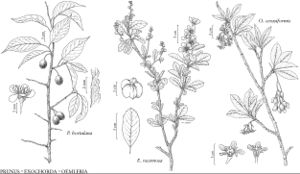Exochorda
Gard. Chron. 1858: 925. 1858.
| Taxon | Illustrator ⠉ | |
|---|---|---|
 | Prunus hortulana Exochorda racemosa Oemleria cerasiformis | Marjorie C. Leggitt Marjorie C. Leggitt Marjorie C. Leggitt |
Shrubs, to 30 (–50) dm. Stems 1–20+, spreading to erect; bark brown to gray-brown on branches, not exfoliating; short-shoots absent; glabrous or sparsely hairy in early season. Leaves deciduous, cauline, alternate; stipules usually absent; petiole present, sometimes relatively short; blade elliptic or oblong to oblong-obovate, 1.5–4.4 (–6) [–9] cm, membranous, margins flat, entire or serrate in distal 1/2, surfaces glabrous or hairy. Inflorescences terminal, 4–10-flowered, racemes, axes glabrous or sparsely hairy prior to expansion of flowers; bracts present; bracteoles present. Pedicels present. Flowers bisexual (plants synoecious), appearing with leaves, 25–50 mm diam.; hypanthium shallowly campanulate to obturbinate, 3.5–4.2 mm, glabrous; sepals 5, ascending, triangular to broad-triangular or semiorbiculate; petals 5, white, [oblong] obovate to suborbiculate, base clawed; stamens 15–20 [–30], shorter than petals; torus absent; carpels 5, connate, glabrous, styles 5; ovules 1 or 2. Fruits capsules, semicircular in outline, shorter than wide or as tall as wide in side view, 6–10 [–15] mm, glabrous; hypanthium not persistent; sepals not persistent. Seeds 1 or 2 per capsule, winged. x = 8.
Distribution
Introduced; Asia, also in Europe, Australia
Discussion
Species 4 (1 in the flora).
Species of Exochorda are attractive, spring-flowering shrubs with racemes of showy, white flowers, and are commonly planted.
Selected References
None.
Lower Taxa
"thin" is not a number."dm" is not declared as a valid unit of measurement for this property.